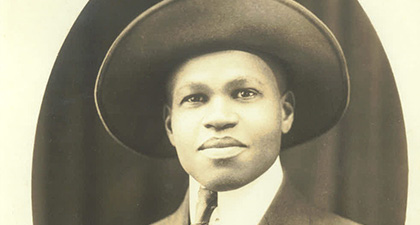In 1912, a young black man left Grenada in a quest for learning. His voyage led him to Canada and conversion to Judaism.
“May you be written in the book of life in the New Year,” says the greeting in Yiddish on the back of a photograph of a black man in a broad-brimmed hat (see picture on cover).
That man, Emerson Swift Mahon, Canada’s first black Jew, sent the picture with a brief letter to Rabbi Herman Abramowitz of the Shaar Hashomayim Synagogue in Montreal.
The letter, dated Nov. 16, 1921, is one of many treasures discovered in the Allan Raymond Collection housed at the Jewish Public Library Archives of Montreal. Raymond, a historical lecturer, retired from the insurance business to devote his time to the study and collection of Canadian and Canadian-Judaic history. Written in English and Hebrew, the letter is a fascinating glimpse of this remarkable man.
“It is to be regretted that I have neglected my study of Hebrew,” Mahon wrote from Winnipeg to the rabbi. “What with the busy whirl of life…I had almost forgotten the saying of the sage.”
That saying is written in Hebrew. “Whoso forgets one word of his study, him the scripture regards as if he had forfeited his life.”
To be black and Jewish in Canada nearly 100 years ago was both unique and challenging. To be also literate in Hebrew and Yiddish was an indication of an unusual and determined personality.
Born an Anglican in 1891, he learned the importance of higher education from his father who was a head teacher in Grenada. His father also instilled in him the importance of the lessons to be learned from Judaism. We cannot be sure what made him interested in Judaism, but perhaps it was the influence of the Sephardi Jewish community in the West Indies, exiled from Spain during the Inquisition.
The educational facilities in the British West Indies being limited, Mahon left the islands for Canada. He farmed in Saskatchewan for two years before joining the Canadian army at the outbreak of World War I. There he met Rabbi Abramowitz, the chaplain to the Jewish soldiers of the Canadian contingent.
Mahon persuaded Rabbi Abramowitz of his sincere desire to convert, and after a lengthy course of instruction in the intricacies of Judaism, an appropriate test of knowledge and a religious ceremony, Rabbi Abramowitz signed the conversion certificate.
After the war Mahon settled in Winnipeg and graduated in 1929 with a science degree from the University of Manitoba. He later received a teacher’s certificate from the Provincial Normal School. Unfortunately, the Depression forced him to accept a job as a sleeping car porter with the Canadian Pacific Railway, which lasted until his retirement in 1956.
Eventually, Mahon possessed one of the finest private Judaic libraries in Canada. At one time, he seriously considered enrolling in a theological seminary, with the intention of becoming a rabbi.
In Winnipeg, Mahon joined Young Judaea, a Zionist youth organization, and quickly rose through the ranks. His work on the railway enabled him to organize chapters throughout Western Canada as well as to photograph every synagogue between Winnipeg and Vancouver.
It is known that he married a woman of Russian-Jewish descent and that the couple had two children, Bill, who still lives in Winnipeg at age 75, and Ethel, who died in 2002.
His skin colour alone made him stand out at any gathering and there was hardly a Jewish person in Winnipeg who did not know him by sight. In fact, on the way to synagogue on Saturday mornings, it was quite common to observe Mahon urging his children, in Yiddish, to hurry along.
Mahon died in 1963 and his wife followed 14 years later.
Eiran Harris is archivist emeritus at the Jewish Public Library in Montreal.
